Journal of Financial Planning: April 2014
Nathaniel Harness, Ph.D., CFP®, is an assistant professor of finance at Texas A&M University-Commerce, where he has served as the program director of the certificate program in financial planning and the coordinator of study abroad programs. His research interests include retirement planning, household financial decision making, household heuristics, and wealth accumulation.
Swarn Chatterjee, Ph.D., CRC®, is an associate professor in the Department of Financial Planning, Housing, and Consumer Economics at the University of Georgia. His research interests include studying the financial planning behavior of households across different stages of their life cycle.
John Salter, Ph.D., CFP®, AIFA®, is an associate professor of personal financial planning at Texas Tech University and wealth manager at Evensky & Katz Wealth Management in Coral Gables, Florida, and Lubbock, Texas.
Executive Summary
- This paper uses a new middle market survey conducted by the Financial Planning Association (FPA), Society of Actuaries (SOA), and the International Foundation for Retirement Education (InFRE) to develop a better understanding of financial planning for the middle market.
- Planners who serve the middle market tend to have flexible revenue models, are less likely to charge hourly fees, and are more likely to generate smaller production levels and maintain lower levels of assets under management (AUM) than those who do not serve the middle market.
- Even though planners with the largest amounts of AUM were found to be less likely to serve the middle market, planners who served the middle market still had practices with average AUM ranging from $10 million to $49 million. This indicates that serving the middle market is not necessarily a barrier to having a successful financial planning practice.
- The three main barriers to serving the middle market include: (1) cost of serving this market, (2) fear; in that middle market clients have a general fear of investing and planning, and (3) poor budgeting and balancing of needs and wants.
The three main client-facing concerns among planners serving this market include: (1) insufficient retirement savings, (2) greater risk of financial ruin in retirement, and (3) insufficient savings for medical emergencies and long-term care (LTC) needs.
According to Meredith (2012), the middle market generally includes clients with net worth ranging from $100,000 to $1 million in investable assets. The typical middle market household has also been the fastest-growing segment in the market for financial advice (Longo 2003). The size of the middle market is large and includes many baby boomers who are at or near retirement. However, because the average amount of investable assets of middle market clients is moderate, these clients are often overlooked and underserved.
Franklin (2011) found that very few planners currently serve the middle market because the lower amounts of assets under management (AUM) deters many financial planners from working with clients who have less than $250,000. As a result, the planners who serve middle market clients have to make up for lower AUM by generating greater client volumes.
A more recent study by Rappaport, Edwards, and Meredith (2013) indicated that the middle market continues to remain underserved, in part because of unique challenges in meeting client needs. These authors used a focus group of FPA practitioners and found that middle market households are typically cash constrained and need the most help in managing their debt. Many of the focus group participants in the study perceived the middle market as unprofitable.
Longo (2003) found that financial planners who successfully work with this group of clients have hired more employees to effectively serve the increased volume of clients associated with this market niche. Further, as the number of clients increases, the planners who serve the middle market gradually increase their hourly fees to maintain profitability and efficiency.
One 2008 study by First Command found that middle income clients need more help with their debt management, emergency fund maintenance, risk management, estate planning, and retirement distribution than they do with wealth accumulation (Kallsen 2010). This group has been coined the “middle class,” “blue collar,” “middle income,” and a host of other names, but the fact remains that fewer practices specialize in this market because client needs can be great while client assets tend to be limited.
Can these middle market clients be served in a way that is still profitable for planners, and if so, does a model exist that can be adopted to meet the need? The purpose of this paper is to begin to answer these questions. This study had three specific objectives. The first was to identify the characteristics of financial planners who work with the middle market. The second was to examine the barriers that planners face when serving middle market clients. Specifically, the study explored the specific issues related to compensation structure, information asymmetry, and planning for clients within this category. The third objective was to describe the various financial planning processes that have been implemented by planners to effectively serve the needs of these clients.
The data used in this paper originated from a survey conducted by FPA, in conjunction with the International Foundation for Retirement Education (InFRE) and the Society of Actuaries (SOA) in March 2012.1 The intent of this survey was to explore the practices of those who work with the middle market. The survey was distributed online to practitioner members of FPA. A total of 358 practitioners responded. Of these respondents, 173 were defined as those who predominately work with “middle market” clients.2 In this paper, the group of middle market planners are referred to as MMPs, while all others are referred to as non-MMPs. The results provide information that planners can use to understand the middle market, learn how to better serve this segment, and determine best practices specific to serving this market demographic.
Working with the Middle Market
Empirical research that has examined a financial planner’s likelihood of serving middle market clients is limited. This study helps address this deficit by showing that among planners surveyed, 40 percent had 20 or more years of experience in the profession, and 23 percent had less than 10 years of experience. As shown in Figure 1, it appears that a large portion of planners who work with middle market clients are well established. Results were similar for the non-MMP group, who had less than 10 years of experience (21 percent), but results varied for those with 20 years or more of experience (49 percent).
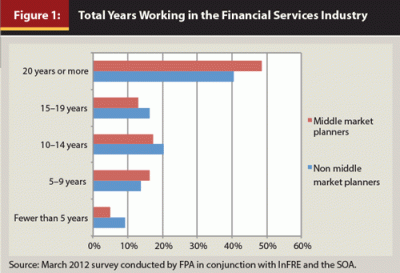
Figure 2 shows that the revenue models for the MMP and non-MMP groups also varied significantly. The majority of MMPs surveyed (51 percent) charged a combination of AUM, hourly fees, retainers, and commissions. Conversely, the largest portion of non-MMPs (39 percent) charged for AUM. Twice as many non-MMPs (13 percent) charged an hourly fee than did the MMPs (6 percent). A commission-only revenue model was the least likely for both groups, with only 2 percent of non-MMPs and 6 percent of MMPs falling in this category.
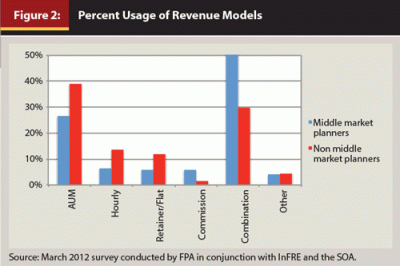
Table 1 shows the distribution of planners across various factors related to serving the middle market. Descriptive statistics indicate a higher percentage of planners with under $50 million in AUM serve the middle market. Conversely, in the larger AUM categories, statistically significant higher percentages are in the non-MMP group. This does not mean MMPs come solely from small practices. As shown, 42 percent of MMPs had AUM of between $10 million and $49 million, and another 13 percent had AUM between $50 million and $100 million.
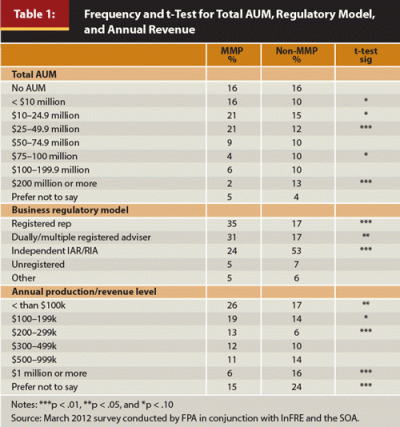
Survey results indicate that a higher percentage of planners who are either registered representatives or are dually registered planners serve the middle market. Likewise, a higher percentage of planners who are registered investment advisers (RIA) or investment adviser representatives (IARs) do not serve the middle market. A higher percentage of those with annual production/revenue levels less than $299,000 are MMPs, whereas a higher percentage of those with production levels greater than $1 million are non-MMPs. The allocation of planners across the middle of the revenue distribution is fairly even.
Empirical Analysis of the Likelihood of Serving the Middle Market
A logistic regression was used to determine the odds of the likelihood of AUM, revenue, experience, business model, and revenue model affecting a planner’s likelihood of serving the middle market. The results of this analysis are shown in Table 2. Findings indicate that planners who have larger amounts of AUM are less likely to serve the middle market. Compared to the reference group of registered representatives, independent RIA/IARs, and other revenue models were less likely to serve the middle market. There was, however, no significant difference between dually registered planners and registered representatives in their likelihood of serving the middle market. Findings also indicate that when compared with the reference group of planners who charge a combination of fees and commissions, those planners who charge hourly fees are less likely to serve the middle market.
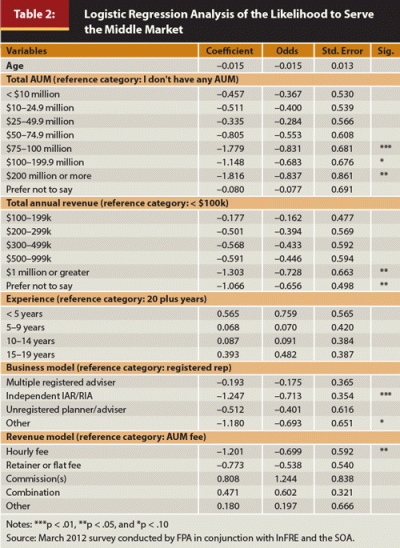
Looking across these factors, it appears that MMPs tend to have more flexible revenue models when serving middle market clients. The MMPs are less likely to charge hourly fees, and are more likely to generate smaller production levels and maintain lower levels of AUM. It would be fair to say that MMPs are not just novice planners who are fresh out of college, eager for new clients. In general terms, MMPs are seasoned planners and are able to generate significant revenue from a predominantly middle market client base. The remainder of this paper will focus on these MMPs to determine the barriers to serving the middle market and the specific advice MMPs give to their middle market clients when establishing a mutually beneficial relationship.
Barriers to Serving the Middle Market
The challenges that planners working in the middle market will face in the coming decades are, in many cases, the exact reasons planners find this market niche so challenging today. A number of issues faced by middle market clients cause some planners to gravitate to paths of lesser resistance. What are these challenges? Planners were asked the following open-ended question: “What are the biggest challenges you face in trying to serve mid-market clients?” Responses were broken into six main factors: (1) fear, (2) cost, (3) not enough assets, (4) life balance/budgeting, (5) financial illiteracy, and (6) multifaceted issues. Panel A of Table 3 summarizes how planners answered this question.
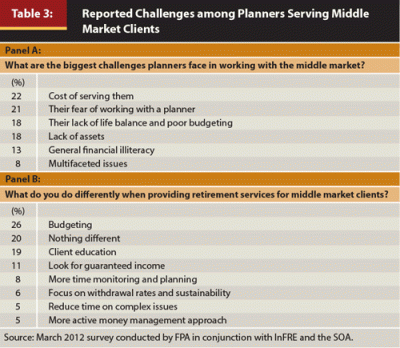
Not surprisingly, the largest reported barrier to serving the middle market is the cost of serving this market niche (22 percent). MMPs made the following types of statements:
- “As a fee-only adviser, my fee is a difficult hurdle for prospective clients to overcome.”
- “How do I charge a fair amount and still make a living?”
Other MMPs seemed to feel that clients perceived that they could not afford financial planning services. These MMPs made statements like:
- “They think they cannot afford us.”
- “There is a lack of awareness by our target market (the American public) on the scope and cost of our services.”
Overall, it appears that for a little less than one quarter of planners who are working with middle market clients, there is the perception that the cost of doing business is a major barrier. In a similar but slightly different vein, lack of assets was also seen as a roadblock to working with middle market clients (18 percent). Responses such as, “assets that are insufficient to generate needed income,” and “lack of investment outside their homes,” demonstrate the challenge of planning for clients with minimal manageable assets.
Fear was the second-largest reported barrier to working with the middle market (21 percent). MMPs perceived that clients were fearful and oftentimes misinformed regarding their services. Consider the following responses:
- “[Clients] have been told to be scared of financial advisers and specific products that they ultimately need.”
- “Getting [clients] to understand that they need as much help as the upper market clients and possibly more.”
Planners also reported that middle market clients had a general fear of investing and planning. This concern is exemplified by the following statements:
- “Lack of their interest in being helped and/or following the plan.”
- “Overcoming investment fears of the market.”
Eighteen percent of planners also perceived that poor budgeting and balancing needs and wants were the greatest barriers to working with the middle market. Responses ranged from simple budgeting to savings problems.
The lack of financial literacy among the middle market was also seen as a barrier to working with this group. Thirteen percent of MMPs saw this as the largest barrier. One planner noted that clients may understand they don’t have enough money, but they don’t know what to do about it. Other planners (8 percent) saw the issues of working with the middle market as multifaceted across all of the aforementioned areas.
Middle market clients also face challenges when contemplating the engagement of a financial planner. MMPs were asked to assess the areas they perceived as the most common problems faced by their middle market clients. The exact question was worded, “To the best of your knowledge, for your middle market clients, what are the most common challenges they face?”
Lack of savings in the middle market was the greatest concern of MMPs. It is not necessarily that middle market clients do not make enough money; rather, it is that clients have not saved enough to meet their future needs. Respondents paint a dire, yet consistent, picture of the challenges facing the middle market. MMPs perceived that their clients will be unable to retire (86 percent) and have longevity in old age (64 percent). Health care expenses and long-term care issues were the third-greatest challenge that MMPs saw their middle market clients facing (62 percent).
Interestingly, investment decisions, market conditions, inflation, and disability were found to be of less importance compared to longevity and asset issues.
How Middle Market Clients Are Being Served
It is clear from the MMP’s responses that working with the middle market has its challenges. There is the perception that middle market clients have too few assets and budgeting issues that cause those clients to feel that working with a planner is out of their reach. The reality is that the middle market needs appropriate planning as much as, or even more than, the high net worth market.
To determine how planners are working with the middle market they were asked, “What do you do differently when providing retirement planning services for middle market clients?” Responses are shown in Panel B of Table 3. The responses were grouped into eight different factors. The No. 1 thing that MMPs do differently for middle market clients involves budgeting (26 percent). Planners offered responses such as:
- “[Clients] require a lot more specificity because they have more limited funds.”
- “More work on budgeting needs versus wants.”
- “I work with them to analyze cash flows, reduce expenses, and increase savings.”
Nineteen percent of MMPs indicated that client education was also critical, even when it meant that a planner need to “get more creative, clearly establish the problem and the range of solutions.”
Other differences in planning for the middle market include the need to look for guaranteed income through insurance and annuity products (11 percent), spending more time planning and monitoring (8 percent), focusing on withdrawal rates and sustainability (6 percent), reducing time spent on more complex tax issues (5 percent), and taking a more active money management approach (5 percent).
It is also worth noting that 20 percent of planners said they do not do anything different when providing retirement planning services for middle market clients. There may be a number of reasons for this, but it is most likely because the group of planners surveyed tend to focus on the middle market and might establish their practice standards around meeting the needs of the average client.
Addressing the Concerns of Middle Market Clients
MMPs were asked a range of additional questions around retirement planning, health care and insurance planning, budgeting, and financial products to determine the specifics of working to meet the needs of their middle market clients. These responses provide a picture of how middle market clients are currently being served. These responses are not necessarily to be viewed as prescribed practices; rather, they can be seen as providing a baseline standard for those who work with middle market clientele.
Retirement issues. As stated earlier, a large problem facing the middle market is the inability to retire using accumulated assets. This shortfall is not easy to overcome, as shifting asset allocations or altering withdrawal rates may not be realistic options for the middle market. When working with clients who do not have enough money to retire as planned, more than 90 percent of MMPs recommend that their clients cut expenses, work part-time in retirement, and/or extend the number of years in the workforce.
Limited resources present a challenge for developing a sustainable retirement planning framework. Limitations also create a need for more specific planning before retirement. Computer-assisted planning models and normative heuristic models are important to help middle market clients bridge the gap between current shortfalls and their retirement goals.
MMPs were asked how they evaluate the likelihood of a successful retirement for middle market clients. The majority use Monte Carlo or other simulation analyses (60 percent), a basic needs analysis (65 percent), and ongoing monitoring of the plan while reviewing their clients’ current and expected fixed and variable expenses and evaluating their income sources (74 percent).
After the likelihood of retirement is evaluated using those techniques, planners must come up with a systematic approach to bridge income and asset gaps. The approach that was reported as most often used is a systematic withdrawal approach, defined as diversifying investments based on a client’s risk profile and managing the total return of the client’s entire portfolio. To provide income, the majority of planners noted withdrawal strategies using either a pre-determined or policy-based amount funded by a combination of interest, dividends, and/or portfolio holdings based on the client’s income needs and economic conditions.
Health care coverage. The third-largest challenge for middle market clients, according to MMPs surveyed, was health care expenses and long-term care issues. Planners were asked about the ways they help their middle market clients manage health care and long-term care risks and costs in retirement.
When it came to long-term care, 65 percent of MMPs assist their clients with long-term care decisions, and 73 percent also provide access to long-term care insurance. Interestingly, a much smaller portion of planners report providing access to health insurance (30 percent) or disability insurance (40 percent). These relatively low proportions result from the fact that most clients are likely covered by employers or outside entities. Planners reported preferring to refer clients to others for Medicare, continuing care facilities, and optimization of state and local based long-term care and home care decisions (74 percent).
Planners were also asked how they determine their clients’ health care and long-term care costs. The most common approach involves conducting a needs analysis that preemptively allows the planner to anticipate additional income needs for health care costs (65 percent). About one-third of MMPs recommend that their middle market clients use a reverse mortgage (31 percent) to cover health care or LTC costs, and about one-quarter (24 percent) recommend clients use health savings accounts to cover these costs. It is common for planners to simply include health care costs as a portion of a retirement needs calculation rather than setting aside earmarked assets to cover retirement health care costs.
Budgeting, investing, and income management. Without a budget, middle market clients are less likely to have AUM. This means that planners who charge for AUM or commissions alone might struggle to remain profitable working in this market niche. Planner responses suggest that a two-tiered approach to the middle market could be a more lucrative and successful model. Stage one includes budgeting, financial education, and goal development. Middle market clients at this stage could be provided with a standardized approach with common heuristics and coaching. This would require flexibility in the practice model, because a planner would likely need to charge a retainer, hourly fee, or a flat fee at this stage of the process. At some point, clients could graduate to stage two when they have enough assets and financial complexity to justify a commission, AUM, or continue on a fee-based model.
MMPs were asked about budgeting and investing with their clients. Responses help set a basic standard for practices when working with the middle market. Planners were first asked how they handle the process of cutting expenses to achieve retirement goals. The majority of planners (55 percent) responded similarly to the following: “After having the conversation that expenses need to be cut, the client(s) determine how they are going to cut their expenses.” A smaller group of planners (36 percent) take a more hands-on approach. For example, one planner stated, “I/someone in my practice analyzes their spending and makes some specific recommendations for cutting expenses.” Three percent refer clients to a financial professional with expertise on budgeting, and 5 percent take a different strategy.
Investment allocation and product selection for the middle market does not appear to be that much different than it is for high net worth clientele, with the exception that the middle market relies more heavily on the use of mutual funds. Planners were asked to select the products that they recommend for their middle market clients to generate retirement income. The majority stated they use bond funds (84 percent) and equity mutual funds (80 percent), followed by dividend paying investments (75 percent), individual bonds (66 percent), exchange-traded funds (56 percent), and real estate investment trusts (53 percent). Very few planners use complex products such as separately managed accounts, limited partnerships, hedge funds, or Treasuries/TIPs when working with their middle market clients.
The largest asset for most middle market clients living in the United States is their home. The financial crisis of 2008 wreaked havoc on real estate assets and depressed the net worth of many middle market clients. Some saw reverse mortgages as a potential retirement income savior. Many planners have been hesitant to jump on the reverse mortgage bandwagon.
Planners were asked, “What percentage of your middle market clients’ assets earmarked for financing retirement are typically invested in their home?” Half of planners said less than 25 percent, and another 33 percent said 25 percent to 49 percent, with the remainder falling in the 50 percent to 100 percent categories. Planners were then asked their approach to leveraging housing wealth. A large percentage of respondents indicated using a varied approach depending upon a client’s objectives (71 percent). Others chose to recommend their clients move to a smaller home or senior housing and invest the additional assets to generate income (62 percent). A much smaller number of planners chose to use a reverse mortgage. Among these planners, some indicated that they would use a reverse mortgage to retire a current traditional mortgage (20 percent), set up a lifetime or period certain stream of income (21 percent), or establish a line of credit (20 percent).
Conclusion
The purpose of this study was to examine the determinants of planners who serve the middle market. Results suggest that, although the middle market may be underserved, there are many financial planners who successfully serve this market. There are, however; some key practice model differences between MMPs and non-MMPs. Most notably is the fact that MMPs tend to have revenue models that allow for more flexible payment methods, while non-MMPs are more likely to use a traditional AUM model. MMPs have smaller practices with reduced production levels than non-MMPs. MMPs are less likely to be independent registered investment advisers.
According to the MMPs surveyed, the main factors of importance when serving the middle market are an increased focus on budgeting, debt management, savings, health care risks, and managing retirement income. Findings also hint at the possibility that issues related to home equity, as a source of retirement income, will grow in the future.
Results from this study indicate that the knowledge needed to serve the middle market is not significantly different from the knowledge needed for working with wealthier counterparts; however, planners working with the middle market will have to offer dynamic solutions with flexible revenue models.
From a practical financial planning perspective, the real hurdle associated with serving the middle market may be conveying the benefits of the planning process to prospective clients. This market likely has the highest need for financial planning, but may not understand the actual need they have as a group. The generalized financial illiteracy of this segment poses a threat to a viable retirement outcome in relation to spending ability and adequate savings. There may be a difference in revenue generation per client, but of course, there are many more middle market clients than there are on the higher wealth scale.
A successful middle and upper market model is one that simultaneously could entail a layered approach where middle market clients receive more coaching around budgeting, financial education, and goal development. These clients would necessitate a more standardized approach with common heuristics and coaching along the way toward wealth accumulation. A flexible revenue model would allow planners to work with these clients based on their needs at any given time. Eventually, clients could graduate, based on assets and financial sophistication, to a second tier of service with strategies and a revenue model more tailored to the needs of those with a growing net worth.
Endnotes
- The proprietary dataset was made available for the purpose of this research. For more information about the data, contact InFRE at www.infre.org/ContactUs.shtml.
- This group was defined as those who reported that more than 50 percent of their clients had total asset of $499,000 or less.
References
Franklin, Mary B. 2011 (August). “Financial Planning for the Middle Class.” Kiplinger.
Kallsen, Terri. 2010 (September). “To Serve the Middle Class, Expand Your Offerings.” Investment News.
Longo, Tracey. 2003 (October 1). “Profits in the Middle-Income Market.” Financial Advisor.
Meredith, Betty. 2012. “How to Serve the Middle Market: Ideas for Planning Approaches and Compensation.” Journal of Financial Planning 25 (8): 24–27.
Rappaport, Anna, Jaleen Edwards, and Betty Meredith. 2013 (April 30). “Approaching the Underserved Middle Market: Insights from Planners—Part II.” Retirement InSight and Trends.
Citation
Harness, Nathaniel, Swarn Chatterjee, and John Salter. 2014. “Financial Planning for the Middle Market.” Journal of Financial Planning 27 (4) 48-54.